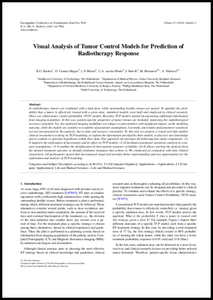Information
- Publication Type: Journal Paper with Conference Talk
- Workgroup(s)/Project(s):
- Date: 2016
- Journal: EuroVis - Eurographics/IEEE-VGTC Symposium on Visualization 2016
- Lecturer:
- Kwan Liu Ma
- Giuseppe Santucci
- Jarke van Wijk
Abstract
In radiotherapy, tumors are irradiated with a high dose, while surrounding healthy tissues are spared. To quantify the prob-ability that a tumor is effectively treated with a given dose, statistical models were built and employed in clinical research.These are called tumor control probability (TCP) models. Recently, TCP models started incorporating additional informationfrom imaging modalities. In this way, patient-specific properties of tumor tissues are included, improving the radiobiologicalaccuracy of models. Yet, the employed imaging modalities are subject to uncertainties with significant impact on the modelingoutcome, while the models are sensitive to a number of parameter assumptions. Currently, uncertainty and parameter sensitivityare not incorporated in the analysis, due to time and resource constraints. To this end, we propose a visual tool that enablesclinical researchers working on TCP modeling, to explore the information provided by their models, to discover new knowledgeand to confirm or generate hypotheses within their data. Our approach incorporates the following four main components: (1)It supports the exploration of uncertainty and its effect on TCP models; (2) It facilitates parameter sensitivity analysis to com-mon assumptions; (3) It enables the identification of inter-patient response variability; (4) It allows starting the analysis fromthe desired treatment outcome, to identify treatment strategies that achieve it. We conducted an evaluation with nine clinicalresearchers. All participants agreed that the proposed visual tool provides better understanding and new opportunities for theexploration and analysis of TCP modeling.Additional Files and Images
Weblinks
No further information available.BibTeX
@article{raidou_eurovis16,
title = "Visual Analysis of Tumor Control Models for Prediction of
Radiotherapy Response.",
author = "Renata Raidou and Oscar Casares-Magaz and Ludvig Paul Muren
and Uulke A van der Heide and Jarle Roervik and Marcel
Breeuwer and Anna Vilanova i Bartroli",
year = "2016",
abstract = "In radiotherapy, tumors are irradiated with a high dose,
while surrounding healthy tissues are spared. To quantify
the prob-ability that a tumor is effectively treated with a
given dose, statistical models were built and employed in
clinical research.These are called tumor control probability
(TCP) models. Recently, TCP models started incorporating
additional informationfrom imaging modalities. In this way,
patient-specific properties of tumor tissues are included,
improving the radiobiologicalaccuracy of models. Yet, the
employed imaging modalities are subject to uncertainties
with significant impact on the modelingoutcome, while the
models are sensitive to a number of parameter assumptions.
Currently, uncertainty and parameter sensitivityare not
incorporated in the analysis, due to time and resource
constraints. To this end, we propose a visual tool that
enablesclinical researchers working on TCP modeling, to
explore the information provided by their models, to
discover new knowledgeand to confirm or generate hypotheses
within their data. Our approach incorporates the following
four main components: (1)It supports the exploration of
uncertainty and its effect on TCP models; (2) It facilitates
parameter sensitivity analysis to com-mon assumptions; (3)
It enables the identification of inter-patient response
variability; (4) It allows starting the analysis fromthe
desired treatment outcome, to identify treatment strategies
that achieve it. We conducted an evaluation with nine
clinicalresearchers. All participants agreed that the
proposed visual tool provides better understanding and new
opportunities for theexploration and analysis of TCP
modeling.",
journal = "EuroVis - Eurographics/IEEE-VGTC Symposium on Visualization
2016",
URL = "https://www.cg.tuwien.ac.at/research/publications/2016/raidou_eurovis16/",
}



